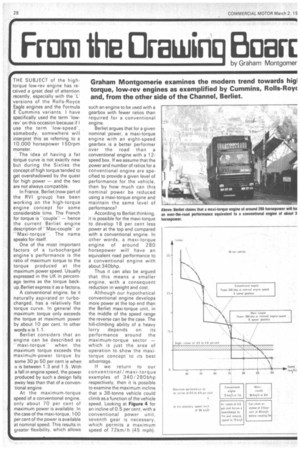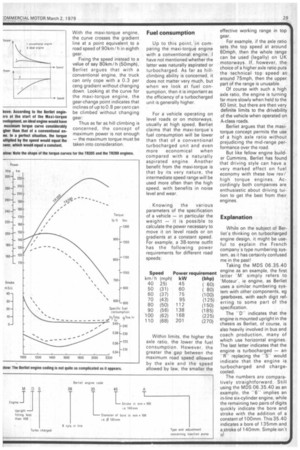I
Page 30

Page 31

If you've noticed an error in this article please click here to report it so we can fix it.
( From the Orewiriq pipping
Graham Montgomerie examines the modern trend towards higl torque, low-rev engines as exemplified by Cummins, Rolls-Royc and, from the other side of the Channel, Berliet.
THE SUBJECT of the hightorque low-rev engine has received a great deal of attention recently, especially with the 'L' versions of the Rolls-Royce Eagle engines and the Formula E Cummins variants. I have specifically used the term lowrev on this occasion because if I use the term 'low-speed', somebody, somewhere will interpret this as referring to a 10,000 horsepower 1 50rpm monster.
The idea of having a fat torque curve is not exactly new but during the Sixties the concept of high torque tended to get overshadowed by the quest for high power — and the two are not always compatible.
In France, Berliet (now part of the RVI group) has been working on the high-torque engine concept for some considerable time. The French for torque is "couple— hence the current Berliet engine description of "Maxi-couple" or "Maxi-torque''. The name speaks for itself.
One of the most important factors of a turbocharged engine's performance is the ratio of maximum torque to the torque produced at the maximum power speed. Usually expressed in the UK in percentage terms as the torque backup Berliet express it as a factoret.
A conventional engine, be it naturally aspirated or turbocharged, has a relatively flat torque curve. In general the maximum torque only exceeds the torque at maximum power by about 10 per cent. In other words a is 1 .1.
Berliet considers that an engine can be described as
maxi-torquewhen the maximum torque exceeds the maximu,m-power torque by
some 30 o 50 per cent ie when oi is between 1 _3 and 1 .5. With a fall in engine speed, the power produced by such a design falls away less than that of a conventional engine.
At the maximum-torque speed of a conventional engine, only about 70 per cent of maximum power is available. In the case of the maxi-torque, 100 percent of the power is available at nominal speed. This results in greater flexibility, which allows such an engine to be used with a gearbox with fewer ratios than required for a conventional engine_
Berliet argues that for a given nominal power, a maxi-torque engine with an eight-speed gearbox is a better performer over the road than a conventional engine with a 12speed box. If we assume that the power and number of ratios for a conventional engine are specified to provide a given level of performance for the vehicle, then by how much can this nominal power be reduced using a maxi-torque engine and maintain the same level of performance?
According to Berliet thinking, it is possible for the maxi-torque to develop 1 8 per cent less power at the top end compared with a conventional engine. In other words, a maxi-torque engine of around 280 horsepower will have an equivalent road performance to a conventional engine with about 340bhp.
Thus it can also be argued that this means a smaller engine, with a consequent reduction in weight and cost.
Although our hypothetical oz conventional engine develops more power at the top end than the Berliet maxi-torque unit, in the middle of the speed range the reverse can be the case. The hill-climbing ability of a heavy
lorry depends on its
performance around the maximum-torque sector — which is just the area of operation to show the maxitorque concept' to its best advantage.
If we return to our conventional/maxi-torque examples of 340 / 280bhp respectively, then it is possible to examine the maximum incline that a 38-tonne vehicle could climb as a function of the vehicle speed. Looking at Figure 4 for an incline of 0.5 percent, with a conventional power unit, seventh gear is necessary, which permits a maximum speed of 72km/ h (45 mph). With the maxi-torque engine, the curve crosses the gradient line at a point equivalent to a road speed of 90km/ h in eighth gear.
Fixing the speed instead to a value of say 80km/ h (50mph), Berliet argues that with a conventional engine, the truck can only cope with a 0.3 per ceng gradient without changing down. Looking at the curve for the maxi-torque engine, the gear-change point indicates that inclines of up to 0.8 per cent can be climbed without changing gear: Thus as far as hill climbing is concerned, the concept of maximum power is not enough — the maximum torque must be taken into consideration_
Fuel consumption
Up to this point, in comparing the maxi-torque engine with a conventional engine, I have not mentioned whether the latter was naturally aspirated or turbocharged. As far as hillclimbing ability is concerned, it does not matter very much, but when we look at fuel consumption, then it is important as the efficiency of a turbocharged unit is generally higher.
For a vehicle operating on level roads or on motorways, usually at high speed, Berliet claims that the maxi-torque's fuel consumption will be lower than that of a conventional turbocharged unit and even more economical when compared with a naturally aspirated engine. Another benefit from the maxi-torque is that by its very nature, the intermediate speed range will be used more often than the high speed, with benefits in noise level and wear.
Knowing the various parameters of the specification of a vehicle — in particular the weight — it is possible to calculate the power necessary to move it on level roads or on gradients at a constant speed. For example, a 38-tonne outfit has the following power requirements for different road speeds: Speed Power requirement km/h (mph) kW (bhp) 40 25) 45 ( 60) 50 (31) 60 ( 80) 60 (37) 75 (100) 70 (43) 95 (125) 80 (50) 112 (150) 90 (56) 138 (185) 100 (62) 168 (225) 110 (68) 201 (270) Within limits, the higher the axle ratio, the lower the fuel consumption. However, the greater the gap between the maximum road speed allowed by the axle and the speed allowed by law, the smaller the effective working range in top gear.
For example, if the axle ratio sets the top speed at around 60mph, then the whole range can be used (legally) on UK motorways. If, however, the choice of a higher axle ratio puts the technical top speed at around 75mph, then the upper part of the range is unusable.
Of course with such a high axle ratio, the engine is turning far more slowly when held to the 60 limit, but there are then very definite limits to the drivability of the vehicle when operated on A-class roads.
Berliet argues that the maxi. torque concept permits the use of a high axle ratio without prejudicing the mid-range performance over the road.
But like fellow engine builder Cummins, Berliet has found that driving style can have a very marked effect on fuel economy with these low rev/ high torque engines. Accordingly both companies are enthusiastic about driving tuition to get the best from their engines.
Explanation
While on the subject of Berliet's thinking on turbocharged engine design, it might be useful to explain the French company's type numbering system, as it has certainly confused me in the past!
Taking the MDS 06.35.40 engine as an example, the first letter "M' simply refers to 'Moteur', ie engine, as Berliet uses a similar numbering system with other components, eg gearboxes, with each digit referring to some part of the specification.
The -Dindicates that the engine is mounted upright in the chassis as Berliet, of course, is also heavily involved in bus and coach production, many of which use horizontal engines. The last letter indicates that the engine is turbocharged — an "13replacing the -Swould indicate that the engine is turbocharged and chargecooled.
The numbers are comparatively straightforward. Still using the MDS 06.35.40 as an example, the -6implies an in-line six-cylinder engine, while the remaining two pairs of digits quickly indicate the bore and stroke with the addition of a constant of 100mm. This 35.40 indicates a bore of 135mm and a,stroke of 140rrim. Simple isn't
it












































































































